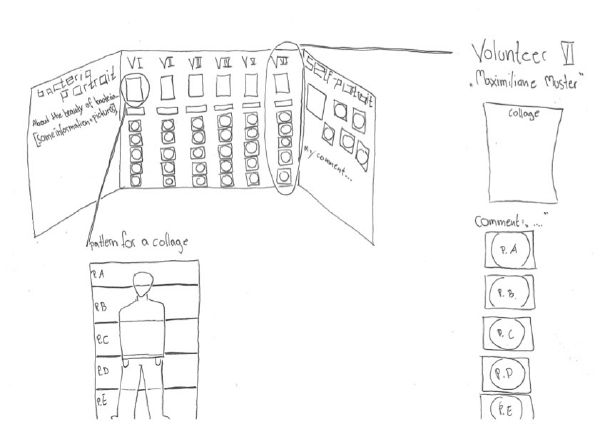Project 1: bacteria portrait
Idea
The idea is to grow bacteria from different parts of the body in separate petri dishes. The cultivated bacteria are to be assembled into a kind of self-portrait.
Futher idea
The next step is to cultivate the body's own bacteria from volunteers. On the one hand, this gives us the opportunity to compare the results. Do our bacteria look similar? How individual are we on our skin? On the other hand, it shows a new side of ourselves. These portraits are meant to show that there is another way to present our self besides photos. But it is important to remember that this idea is a speculation and not a scientific experiment. There is no proof that the bacteria grown are actually endogenous.
Medium
For the cultivation of bacteria you can use the LB - medium.
Ingredient
- Yeast extract (5g/l)
- tryptone (10g/l)
- sodium chloride (0.5-10g/l)
- agar (15g/l)
- sodium hydroxide to adjust the pH to 7.
The medium is autoclaved for 20 minutes at 121 degrees.
Realisation
The bacteria are transferred from five different body sites to five different Petri dishes with a cotton swab: Petri dish (P.) A - eyes, P. B - oral cavity, P. C - belly button, P.D - vagina, P.E – feet
The bacteria have grown for 2 weeks. The temperature was usually 20 degrees.
P. A-E after two weeks
Presentation
photo collage
Combining only the photos of the bacteria or combining the photos of the bacteria with photos from the person. If the collages are made in the same pattern, they are at the same time an individual portrait and comparable.
exhibition
Photos of each person's individual bacterial cultures are displayed side by side. This shows the answer to the question: How different are our bacteria?
To get to the bottom of the question 'is this a potential way to present oneself', comments are added by the volunteers. One to three sentences about their first thoughts when they saw their bacteria portraits.
Interactive part: In this experiment only 5 body parts are looked at. But there are many more bacteria to discover on human bodies. Therefore, petri dishes with colonies are provided. The visitors can guess which part of the body it is. The solution can then be looked at independently.
Project 2: bakteria exchange
How do bacteria from foreign bodies react when they meet. Can this be made visible?















